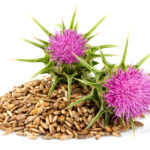Fascinating milk thistle compound offers liver-protective benefits
 (NaturalHealth365) Nonalcoholic fatty liver disease (NAFLD) is exactly what it sounds like – an accumulation of fat in the liver, along with a history of little or no drinking of alcoholic beverages. NAFLD is extremely common – some experts estimate its prevalence as up to 45 percent of the population in industrialized North America and Europe – and can be quite mild, with no noticeable symptoms.
(NaturalHealth365) Nonalcoholic fatty liver disease (NAFLD) is exactly what it sounds like – an accumulation of fat in the liver, along with a history of little or no drinking of alcoholic beverages. NAFLD is extremely common – some experts estimate its prevalence as up to 45 percent of the population in industrialized North America and Europe – and can be quite mild, with no noticeable symptoms.
Recent research highlights the potential benefits of silymarin, the active compound in milk thistle, for improving liver enzyme levels in individuals with liver conditions. A systematic review analyzing 29 randomized clinical trials found that 65.5% of studies reported reduced liver enzyme levels after silymarin supplementation, particularly in patients with nonalcoholic fatty liver disease.
In severe cases, NAFLD is the start of a deadly progression that begins with excess fat in the liver, develops into nonalcoholic steatohepatitis – which involves liver inflammation and fibrosis – and ultimately results in such life-threatening complications as cirrhosis of the liver, liver cancer, and liver failure. So, let’s see how milk thistle, a natural herb, can help to prevent liver damage.
Can milk thistle reduce the threat of NAFLD?
Milk thistle, scientifically known as Silybum marianum, has long been prized by herbalists and naturopaths as a tonic to help combat chronic liver and kidney problems. Now, animal and human studies have begun to reveal the extent of milk thistle’s potential and its multiple mechanisms of action – and supported its use as a safe and extremely promising compound to maintain healthy liver function.
The active compound in milk thistle, known as silymarin, is a complex of flavonolignans believed to offer antioxidant and supportive properties. These properties help protect cells from oxidative stress, which can affect overall liver health. Silymarin may also support the body’s natural detoxification processes by promoting healthy bile flow and aiding in the elimination of certain substances.
What is metabolic syndrome, and how can milk thistle help protect the liver?
Metabolic syndrome is the overarching term for a laundry list of unhealthy conditions, which include abdominal obesity, high blood pressure, inadequate blood sugar control, and excess fat in the bloodstream. Metabolic syndrome is particularly harmful to the liver – as your system’s first line of defense against toxins, your liver bears the brunt of the impact of damaging substances such as fats, sugars, free radicals, and medications.
Simply put, milk thistle improves liver function across the board. More specifically, it detoxifies the liver, reduces the harm caused by oxidative stress, regulates the metabolism of fats, and helps to clear the blood of toxins – thereby suppressing insulin resistance, inflammation, and obesity that contribute to both metabolic syndrome and its likely consequence: NAFLD.
Milk thistle extracts can change the very structure of liver cells to boost cell defense mechanisms – including increasing the amount and function of mitochondria in liver cells. It is because of this cell-changing property that many researchers are crediting milk thistle with the ability to protect against liver fibrosis and the subsequent progression to cirrhosis.
Although silybin and silymarin are sometimes used as if they are synonymous, they are not quite the same thing. Silybin, which constitutes about 50 to 70 percent of silymarin extract, is one of 7 constituents that make up silymarin. An extremely strong antioxidant, silybin is considered the most active ingredient in silymarin.
What other studies support the ability of milk thistle extracts to help ward off NAFLD and its complications?
In a 2013 clinical study published in the World Journal of Hepatology, the research team concluded that silybin effectively reduces fatty liver’s biochemical, inflammatory, and ultrasonic indices.
In an eight-week study published in the Caspian Journal of Internal Medicine, patients with nonalcoholic steatohepatitis were divided into two groups. All participants were given recommendations for lifestyle changes in diet and exercise, but only one group was given 210 mg of silybin daily. The silybin group had significantly greater reductions in serum enzymes overall than the control group that didn’t receive the extract.
Researchers recognized that silybin is a “useful” herbal treatment and noted its safety and lack of adverse effects.
What’s the best way to use milk thistle extracts?
Look for non-GMO, non-irradiated milk thistle products that are standardized to contain 70 to 80 percent silymarin – usually available in 120 to 140-milligram formulations. Because silymarin and its constituents don’t dissolve well in water, look for silymarin-phosphatidylcholine complex; the lipid boosts absorption of the silymarin for maximum health benefits.
This enhanced delivery system may allow the body to utilize the beneficial compounds in milk thistle better, potentially increasing its supportive effects on liver health. Some formulations may also combine milk thistle with other traditional, complementary herbs to promote overall wellness.
Editor’s note: I highly recommend LuvByNature LiverLuv for a high quality, milk thistle supplement to support liver health.
Consistency is key when using milk thistle extracts. For best results, follow the guidelines on the product label or consult a qualified holistic health professional for personalized recommendations.
Milk thistle supplements are commonly available in capsule, softgel, or tincture form, providing options for different preferences. Taking milk thistle with a meal containing healthy fats may be beneficial to further improve absorption.
When choosing a product, opt for brands that undergo third-party testing to ensure purity and potency, helping to guarantee that you’re receiving a high-quality supplement. As with any wellness routine, integrating milk thistle into a balanced lifestyle can support your body’s natural processes over time.
Editor’s note: Discover the many natural ways to avoid fatty liver disease, own the Fatty Liver Docu-Class created by NaturalHealth365 Programs.
Sources for the article include:



